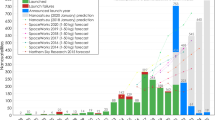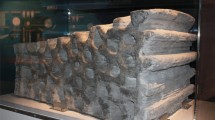Abstract
As an important subject of space technology, material exposure experiments provide data not only for material selection in spacecraft design but also for new materials research and development. It is usually expensive and time-consuming to carry out traditional missions of material exposure experiments on large space vehicles, such as space stations or satellites. Therefore, in this paper, a CubeSat-based platform is proposed to accelerate this type of mission cycle. Within the 3U envelope of CubeSat, a design strategy of a deployable structure is adopted to enlarge exposable surfaces. This strategy enables a reconfigurable architecture to meet the size and volume requirements during the launch stage and increase the areas to be exposed in space by up to 40%. The degradation statuses of the material samples are directly monitored by an optical camera. To ensure sufficient coverage of the visual field, a differential rotation mechanism is designed to drive petaloid double-layer sample trays. Graphic data of samples may be transmitted to the ground in a timely manner at a proper orbital altitude. Thermal and modal analyses for Material Exposure CubeSat (MEC) are also included in this paper. Finally, a 3D-printing prototype is manufactured to examine the feasibility of the differential rotation system and visual coverage of sample trays. Overall, the MEC proposed in this paper exhibits a novel platform to conduct material exposure experiments in space with the advantages of low development cost, short production cycle and portable volume.












Similar content being viewed by others
References
Gilmore D. G.: Spacecraft Thermal Control Handbook, volume 1: Fundamental Technologies. El Segundo, CA (2002). https://doi.org/10.2514/4.989117
Blockley, R., Shyy, W.: Encyclopedia of aerospace engineering. American Institute of Aeronautics and Astronautics, Inc (2010). https://doi.org/10.1002/9780470686652
Miller, S.K., Banks, B.A., Waters, D.L.: Investigation into the differences between atomic oxygen erosion yields of materials in ground-based facilities and LEO. High Perform. Polym. 20(4–5), 523–534 (2008). https://doi.org/10.1177/0954008308089711
Engelhart, D.P., Cooper, R., Cowardin, H., Maxwell, J., Plis, E., Ferguson, D., Hoffmann, R.: Space weathering experiments on spacecraft materials. J. Astronaut. Sci. 66(2), 210–223 (2019). https://doi.org/10.1007/s40295-019-00175-2
Leger, L.: Oxygen atom reaction with shuttle materials at orbital altitudes-Data and experiment status. In 21st Aerospace Sciences Meeting (1983). https://doi.org/10.2514/6.1983-73
Smeenk, N.J., Mooney, C., Feenstra, J., Mulder, P., Rohr, T., Semprimoschnig, C.O.A., Schermer, J.J.: Space environmental testing of flexible coverglass alternatives based on siloxanes. Polym. Degrad. Stab. 98(12), 2503–2511 (2013). https://doi.org/10.1016/j.polymdegradstab.2013.09.008
Tahara, H., Zhang, L., Hiramatsu, M., Yasui, T., Yoshikawa, T., Setsuhara, Y., Miyake, S.: Exposure of space material insulators to energetic ions. J. Appl. Phys. 78(6), 3719–3723 (1995). https://doi.org/10.1063/1.359951
Thibeault, S. A., Cooke, S. A., Ashe, M. P., Saucillo, R. J., Murphy, D. G., de Groh, K. K., Nguyen, Q. V.: MISSE-X: an ISS external platform for space environmental studies in the post-shuttle era. In 2011 Aerospace Conference, IEEE (2011). https://doi.org/10.1109/AERO.2011.5747619
Horneck, G., Klaus, D.M., Mancinelli, R.L.: Space microbiology. Microbiol. Mol. Biol. Rev. 74(1), 121–156 (2010). https://doi.org/10.1128/MMBR.00016-09
Imai, F., Imagawa, K.: NASDA’s space environment exposure experiment on ISS-first retrieval of SM/MPAC&SEED. Mater Space Environ 540, 589–594 (2003)
Kinard, W., O’Neal, R., Wilson, B., Jones, J., Levine, A., Calloway, R.: Overview of the space environmental effects observed on the retrieved Long Duration Exposure Facility (LDEF). Adv. Space Res. 14(10), 7–16 (1994). https://doi.org/10.1016/0273-1177(94)90444-8
Calle, C.I., Mackey, P.J., Hogue, M.D., Johansen, M.R., Yim, H., Delaune, P.B., Clements, J.S.: Electrodynamic dust shields on the international space station: Exposure to the space environment. J. Electrostat. 71(3), 257–259 (2013). https://doi.org/10.1016/j.elstat.2012.10.009
Dever, J.A., Miller, S.K., Sechkar, E.A., Wittberg, T.N.: Space environment exposure of polymer films on the materials international space station experiment: Results from MISSE 1 and MISSE 2. High Perform. Polym. 20(4–5), 371–387 (2008). https://doi.org/10.1177/0954008308089704
Crusan, J., Galica, C.: NASA’s CubeSat Launch Initiative: Enabling broad access to space. Acta Astronaut. 157, 51–60 (2019). https://doi.org/10.1016/j.actaastro.2018.08.048
Alicia Johnstone: CubeSat design specification Rev. 14. The CubeSat Program, Cal Poly SLO (2020).
Shkolnik, E.L.: On the verge of an astronomy CubeSat revolution. Nature Astronomy. 2(5), 374–378 (2018). https://doi.org/10.1038/s41550-018-0438-8
Ikeya, K., Sakamoto, H., Nakanishi, H., Furuya, H., Tomura, T., Ide, R., Yamazaki, M.: Significance of 3U CubeSat OrigamiSat-1 for space demonstration of multifunctional deployable membrane. Acta Astronaut. 173, 363–377 (2020). https://doi.org/10.1016/j.actaastro.2020.04.016
Villela, T., Costa, C.A., Brandão, A.M., Bueno, F.T., Leonardi, R.: Towards the thousandth CubeSat: a statistical overview. Int. J. Aerosp. Eng. 2019, 1–13 (2019). https://doi.org/10.1155/2019/5063145
Selva, D., Krejci, D.: A survey and assessment of the capabilities of Cubesats for Earth observation. Acta Astronaut. 74, 50–68 (2012). https://doi.org/10.1016/j.actaastro.2011.12.014
Poghosyan, A., Golkar, A.: CubeSat evolution: Analyzing CubeSat capabilities for conducting science missions. Prog. Aerosp. Sci. 88, 59–83 (2017). https://doi.org/10.1016/j.paerosci.2016.11.002
Hakima, H., Bazzocchi, M.C., Emami, M.R.: A deorbiter CubeSat for active orbital debris removal. Adv. Space Res. 61(9), 2377–2392 (2018). https://doi.org/10.1016/j.asr.2018.02.021
Udrea, B., Nayak, M.: A cooperative multi-satellite mission for controlled active debris removal from low Earth orbit. In 2015 IEEE Aerospace Conference. 2015, 1–15 (2015). https://doi.org/10.1109/AERO.2015.7118940
de Groh, K.K., Banks, B.A., McCarthy, C.E: NASA-HDBK-6024. (2014).
Xia, D.H., Song, S., Tao, L., Qin, Z., Wu, Z., Gao, Z., Wang, J., Hu, W., Behnamian, Y., Luo, J.L.: Review-material degradation assessed by digital image processing: Fundamentals, progresses, and challenges. J. Mater. Sci. Technol. 53, 146–162 (2020). https://doi.org/10.1016/j.jmst.2020.04.033
Xia, D.H., Ma, C., Song, S., Jin, W., Behnamian, Y., Fan, H., Wang, J., Gao, Z., Hu, W.: Atmospheric corrosion assessed from corrosion images using fuzzy Kolmogorov-Sinai entropy. Corros. Sci. 120, 251–256 (2017). https://doi.org/10.1016/j.corsci.2017.02.015
Kimoto, Y., Yukumatsu, K., Goto, A., Miyazaki, E., Tsuchiya, Y.: MDM: a flight mission to observe materials degradation in-situ on satellite in super low Earth orbit. Acta Astronaut. 179, 695–701 (2021). https://doi.org/10.1016/j.actaastro.2020.11.048
Zimcik, D.G., Maag, C.R.: Results of apparent atomic oxygen reactions with spacecraft materials during shuttle flight STS-41G. J. Spacecr. Rocket. 25(2), 162–168 (1988). https://doi.org/10.2514/3.25965
Zhao, X.H., Shen, Z.G., Xing, Y.S., Ma, S.L.: An experimental study of low earth orbit atomic oxygen and ultraviolet radiation effects on a spacecraft material-polytetrafluoroethylene. Polym. Degrad. Stab. 88(2), 275–285 (2005). https://doi.org/10.1016/j.polymdegradstab.2004.11.002
Gao, X., Hu, M., Fu, Y., Weng, L., Liu, W., Sun, J.: MoS2-Au/Au multilayer lubrication film with better resistance to space environment. J. Alloy. Compd. 815, 152483 (2020). https://doi.org/10.1016/j.jallcom.2019.152483
Sebestyen, G., Fujikawa, S., Galassi, N., Chuchra, A.: Low Earth Orbit Satellite Design. Springer International Publishing (2018). doi: https://doi.org/10.1007/978-3-319-68315-7
Solís-Santomé, A., Urriolagoitia-Sosa, G., Romero-Ángeles, B., Torres-San Miguel, C.R., Hernández-Gómez, J.J., Medina-Sánchez, I., Couder-Castañeda, C., Grageda-Arellano, J.I., Urriolagoitia-Calderón, G.: Conceptual design and finite element method validation of a new type of self-locking hinge for deployable CubeSat solar panels. Adv. Mech. Eng. 11(1), 1687814018823116 (2019). https://doi.org/10.1177/1687814018823116
Rapp, S., Baier, H.: Determination of recovery energy densities of shape memory polymers via closed-loop, force-controlled recovery cycling. Smart Mater. Struct. 19(4), 045018 (2010). https://doi.org/10.1088/0964-1726/19/4/045018
Bhattarai, S., Kim, H., Jung, S.H., Oh, H.U.: Development of pogo pin-based holding and release mechanism for deployable solar panel of CubeSat. Int. J. Aerosp. Eng. 2019, 2580865 (2019). https://doi.org/10.1155/2019/2580865
Oh, H.U., Lee, M.J.: Development of a non-explosive segmented nut-type holding and release mechanism for cube satellite applications. Trans. Jpn. Soc. Aeronaut. Space Sci. 58(1), 1–6 (2015). https://doi.org/10.2322/tjsass.58.1
Muri, P., McNair, J.: A survey of communication sub-systems for intersatellite linked systems and cubesat missions. J. Commun. 7(4), 290–308 (2012). https://doi.org/10.4304/jcm.7.4.290-308
Hasan, M.A., Rashmi, S., Esther, A., Bhavanisankar, P.Y., Sherikar, B.N., Sridhara, N., Dey, A.: Evaluations of silica aerogel-based flexible blanket as passive thermal control element for spacecraft applications. J. Mater. Eng. Perform. 27(3), 1265–1273 (2018). https://doi.org/10.1007/s11665-018-3232-y
Kim, H., Cheung, K., Auyeung, R.C., Wilson, D.E., Charipar, K.M., Piqué, A., Charipar, N.A.: VO2-based switchable radiator for spacecraft thermal control. Sci. Rep. 9(1), 1–8 (2019). https://doi.org/10.1038/s41598-019-47572-z
Nason I., Puig-Suari J., Twiggs R.: Development of a family of picosatellite deployers based on the CubeSat standard. In Proceedings, IEEE Aerospace Conference. 1, 1-1 (2002). doi: https://doi.org/10.1109/AERO.2002.1036865
Ampatzoglou, A., Kostopoulos, V.: Design, analysis, optimization, manufacturing, and testing of a 2U cubesat. Int. J. Aerosp. Eng. 2018, 1–15 (2018). https://doi.org/10.1155/2018/9724263
Morettini, G., Zucca, G., Braccesi, C., Cianetti, F., Dionigi, M.: Cubesat spatial expedition: an overview from design to experimental verification. IOP Conf. Ser. Mater. Sci. Eng. 1038(1), 012026 (2021). https://doi.org/10.1088/1757-899X/1038/1/012026
Japan Aerospace Exploration Agency (JAXA): small satellite deployment interface control document version D. In JEM payload accommodation handbook. 8, 16 (2013).
Almazrouei, A., Khan, A., Almesmari, A., Albuainain, A., Bushlaibi, A., Al Mahmood, A., Alqaraan, A., Alhammadi, A., AlBalooshi, A., Khater, A., Alharam, A.: A complete mission concept design and analysis of the student-Led CubeSat Project: Light-1. Aerospace 8(9), 247 (2021). https://doi.org/10.3390/aerospace8090247
Wijker J.: Miles’ equation in random vibrations: theory and applications in spacecraft structures design. Spring Nature (2018).
Acknowledgements
This work is supported by the foundation from the China Manned Space Engineering Program and the National Natural Science Foundation of China under Grant No. 42171445.
Author information
Authors and Affiliations
Corresponding authors
Ethics declarations
Conflict of interest
The authors declare no conflicts of interest or competing interests.
Additional information
Publisher's Note
Springer Nature remains neutral with regard to jurisdictional claims in published maps and institutional affiliations.
Rights and permissions
Springer Nature or its licensor holds exclusive rights to this article under a publishing agreement with the author(s) or other rightsholder(s); author self-archiving of the accepted manuscript version of this article is solely governed by the terms of such publishing agreement and applicable law.
About this article
Cite this article
Xiao, L., Shi, W., Li, X. et al. A novel design of a deployable CubeSat for material exposure missions in low earth orbit. CEAS Space J 15, 641–653 (2023). https://doi.org/10.1007/s12567-022-00470-z
Received:
Revised:
Accepted:
Published:
Issue Date:
DOI: https://doi.org/10.1007/s12567-022-00470-z




